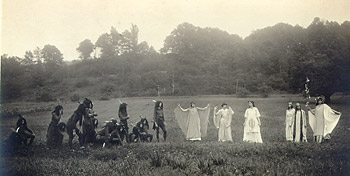Why Deerfield?
Films and Pageants, Portraying Colonial Heritage
From the Pocumtucks to Pynchon to the Present
The Old Deerfield Pageant brochure of 1910 promised to "embrace episodes" of Deerfield's history, "from the purchase of the lands by John Pynchon...until after the war of the Revolution." Arguing for the authenticity of their story, the brochure advertised that "many of the...cast are lineal descendants of the early settlers of Deerfield and Greenfield and well represent their ancestors in the pageant scenes."1 The familial ties binding the re-enactors to their ancestors could be seen in more than just their faces. Their story smoothed away the more uncomfortable aspects of a history that, on a local and national scale, had included both winners and losers. They suggested, instead, that their ancestors' actions were benign and their success was predestined. In referring to a scene about the "Purchase of the Pocumtuck lands by John Pynchon of Springfield," for instance, the pageant brochure assures the reader that "they [the Pocumtucks] were really deprived of nothing."2 The prominent use of allegorical figures, which suggest historical forces in symbolic form, signaled how a particular pageant episode should be read and understood. These ideas, embodied in a female form, were meant to illuminate how the events of Deerfield's past had resulted in its present.
- Old Deerfield Pageant brochure, 1910, PVMA Library.
- ibid.
 In Their Words
In Their Words
 Comparisons
Comparisons

© Memorial Hall Museum, Pocumtuck Valley Memorial Association
"Indians Glimpse a Vision of the Future"
A group of 'Indians' watch as the 'Spirit of Vision' reveals several classically-draped female figures, representing 'Agriculture', 'Industry', 'War', and the promising future of towns in the Connecticut River Valley. They symbolically point to a coming time of progress and prosperity in which Native Americans will have no place. Frances and Mary Allen, pageant photograph, 1916.


















